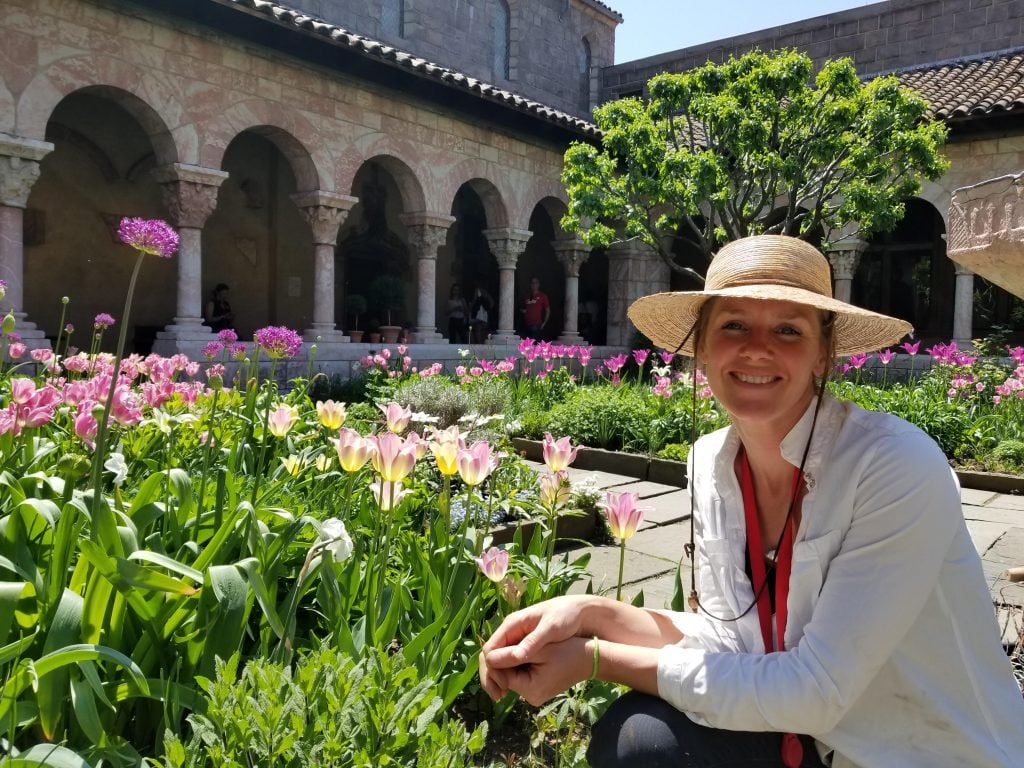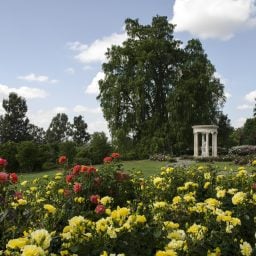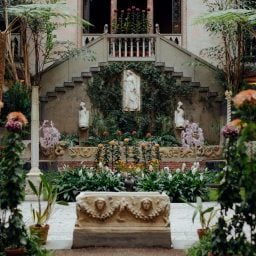Carly Still, the managing horticulturalist at the Met Cloisters has, over the course of her career, sought to merge the worlds of art and nature. When she began working at the museum 10 years ago, she was blown away by the intimacy of the four, sectioned-off medieval gardens, their carefully curated plant collections, and how they corresponded to the lore and mythology of the collection’s sculptures, tapestries, illuminated manuscripts and other treasures.
We got on the phone with Still to discuss the ins and outs of life as a museum horticulturalist, how she got into the field, and what visitors to the Met Cloisters can expect in the coming months—including a bursting holiday display, complete with bay laurel, polished apples, and fragrant holly, beginning December 16. Read on to find out more, below.
How did you become interested in horticulture in the first place?
That’s a great question. My background actually was in printmaking. I studied at SUNY New Paltz, and I got my Bachelor of Fine Arts and focused in printmaking. I think through my art practice, I became interested in plants. A lot of my work was just abstract and organic. So I started looking at plants for artistic inspiration, and then I thought: “Oh, I bet it would be really great to learn more about these.”
A family friend of mine had a gardening business, so I just called her one day—it was the summer, I was off from college—and I just said, “Hey. I’m interested in learning more about gardening. By chance would you be looking for some new members on your crew?” And she hired me and I fell in love with the work almost instantaneously.
I think it’s like most gardeners. Once you start, it’s just this lifelong relationship that you want to keep developing. I felt like it was a calling. The quiet, meditative side of gardening is what I really like.
I never really realized when I started what a world of work there actually is. I was in upstate New York and loading pallets of soil and mulch into the back of a pickup truck. It was really, really tough work. But when I came into the city and discovered the Botanical Gardens and just this whole other industry of work, then I realized that it actually could be a profession.
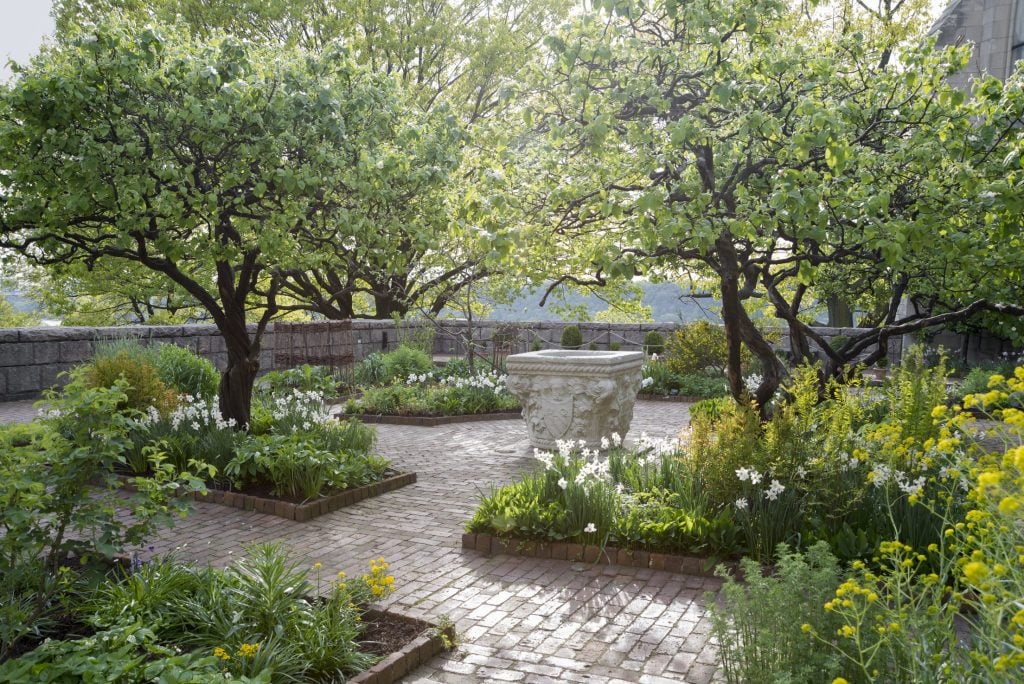
The Bonnefont herb garden. Photo courtesy the Metropolitan Museum of Art.
How did you end up at the Cloisters?
I feel just really lucky. At the time, I had moved to Brooklyn and was interning at a paper mill in a print shop, and really wanting to get my hands in the soil, just missing gardening. And I was looking for work on NYFA [the New York Foundation for the Arts]. I found this listing at the Metropolitan Museum of Art, and I thought, “Oh my God. This sounds amazing.” I’d never visited the Cloisters, but in the job description, they described the orchard maintenance, planting and maintaining the gardens, and greenhouse work. It was a part-time position, but I thought, “This is a really beautiful fusion between the two things that I love: art and gardening.”
So of course I applied, and then came to visit the museum before I had my interview. I was just blown away by these small, intimate spaces. The woman who interviewed me was showing me around and there’s this beautiful little shed where they dry herbs and the collections of plants were just incredible. And I just thought, “What a jewel this place is.”
I was so nervous. But I think at the time, the woman who was in charge of the gardens, Deidre, probably liked me because I had a background in fine art and really gravitated towards the herb garden. She was an amazing plant historian and really taught me this world of storytelling. The lore was where her strength was.
I was over the moon when they offered me the position. I felt like it really transformed my life in so many ways. It was a very humble, three days a week, seasonal job, but then it grew from there.
In what ways did it grow? And how did your research and knowledge of the space begin to shape your role?
There’s really only three positions in our tiny little department. And the woman who had the assistant position left shortly after I started. So that full-time, year-round position opened up really quickly and I applied for that and I got the promotion.
Deirdre Larkin was managing the gardens at that point. I think she really encouraged me to learn all the plants. So I was also taking classes at the New York Botanical Gardens to get my certification in horticulture. She told me to take coursework and then also gave me so much material to read, even though obviously it wasn’t required. But she knew my curiosity was there.
Once you start going in the herb garden, there are hundreds of plants, but you want to learn everything about each one. So I was reading like crazy on the train. At the time, there was also the Medieval Garden Enclosed blog, which was where Deirdre put her energy, into writing about the lore and the history of all of the plants. I just ate that up.
Each garden—there are three small, intimate gardens here—tells a different story and they have a different group of plants that we’re cultivating in them. So I wanted to be familiar and comfortable working in each garden space. I was trying to shape my way here, and mold myself into someone that would be useful.
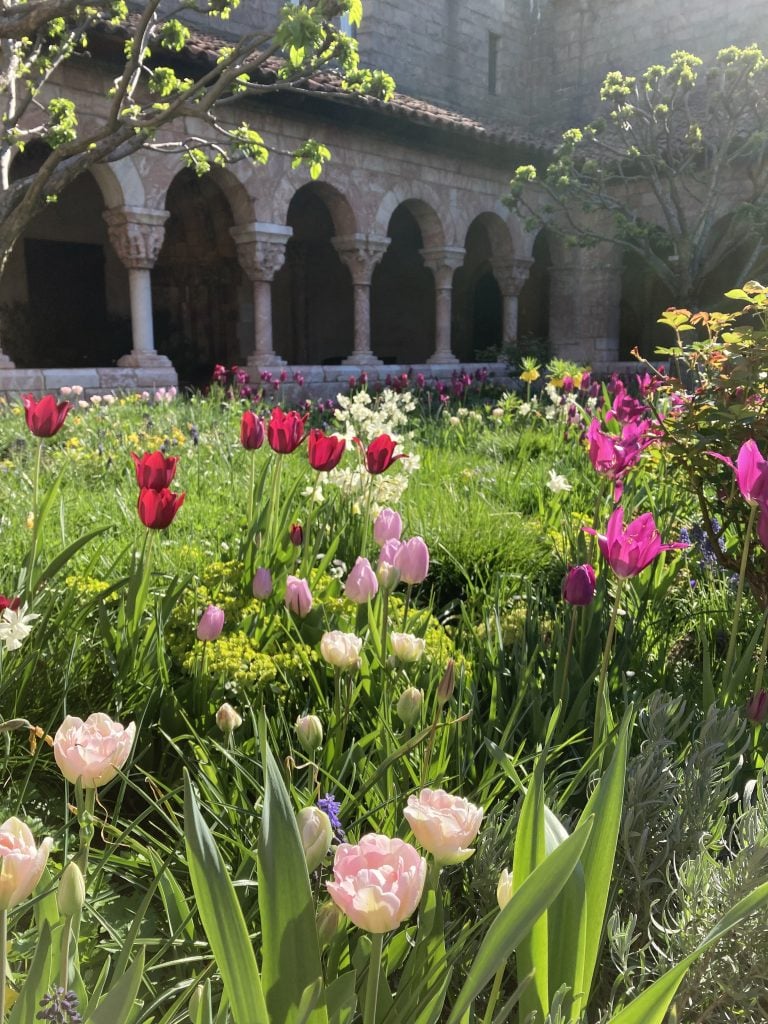
The Cuxa Cloister at the Met Cloisters. Photo courtesy the Metropolitan Museum of Art.
What were the challenges of becoming the kind of horticulturalist you wanted to be?
There’s this idea of not wanting to leave a trace. That’s how I like to view the gardens. You want to have a hand in them, but you don’t want to ever show that, right? It should look effortless.
That was the main thing, but I was given a lot of room to grow. When Deirdre left, I worked under Caleb Leech, and he was so talented. He was a real plants man. Over time, I gained a lot of confidence in my work as a gardener while working with him and tried not to take it all too seriously. At the end of the day, they’re just plants. They’re very forgiving.
So all this led me to where i am now, as the manager, which feels kind of funny. And I just hired two new awesome women gardeners and they’re great.
When you say you want to make the most beautiful gardens, what does that mean to you?
We have herbs dotted through all of the spaces in the ornamental garden and through the herb garden, and for me, the beauty is really in the fragrance. Having fragrant flowers that people can interact with is really important. Upstairs in the ornamental garden, I always talk about the heritage David Austin English Roses. There’s lavender all over the place up there.
It is also all about having beautiful flowers throughout the season. That starts with our bulb display, which bloom in early spring. It’s overwhelmingly beautiful. We have all of these amazing tulips, fabulous alliums, an explosion of crocus around that time of year. And of course daffodils. All the favorites are up there—dianthus, foxgloves, delphiniums, iris, the martagon lilies, astrantia. We’ve got all sorts of beautiful perennials up there.
Chocolate cosmos is one of my favorites that’s got a fabulous fragrance as well. A beautiful flower form, and a really nice contrast with that dark, rich, kind of blood red. And then we’ve got some nice, silvery foliage with the artemisias.
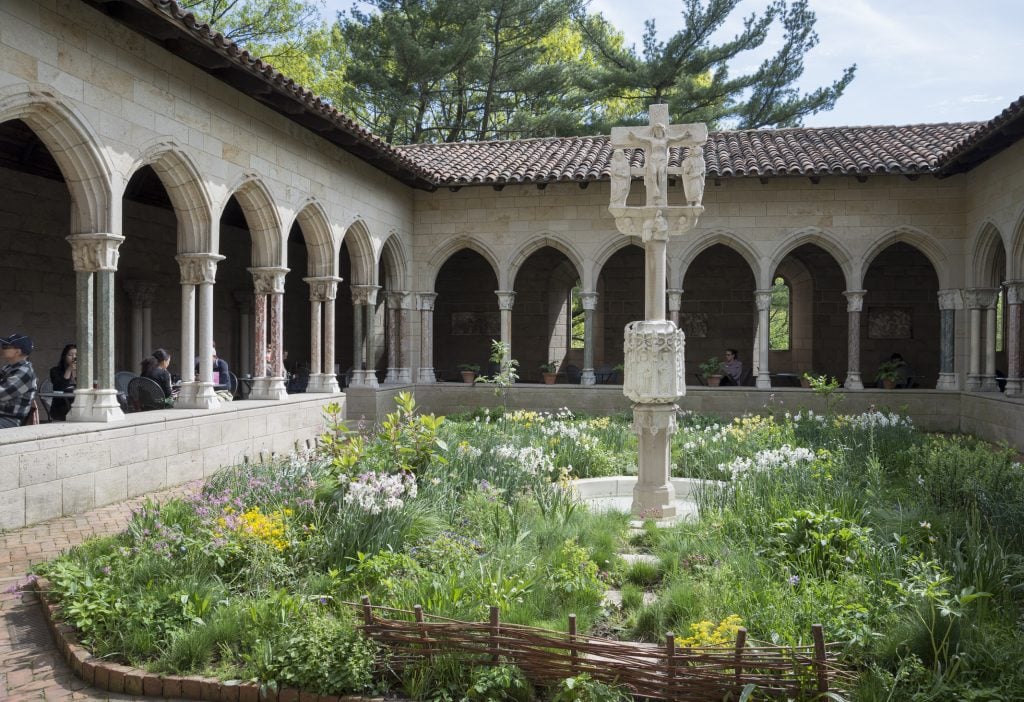
The Trie Cloister. Photo courtesy the Metropolitan Museum of Art.
That all sounds really beautiful.
That’s what people gravitate towards because there are more flowers throughout the season upstairs. But then the herb garden in the spring is overwhelmingly beautiful. We have lots of other garden favorites down there too, again the foxgloves will be in full bloom and the valerian and the woad, used for the famous blue dye.
And then the Trie-en-Bigorre garden is magical too. That was replanted about five years ago we’re still working our way into that space. We just planted a bunch of species tulips, more crocus, more irises, lots of dianthus. The adonis is amazing. There’s just so many spring-blooming plants there that are also inspired by the Unicorn Tapestries in the collection.
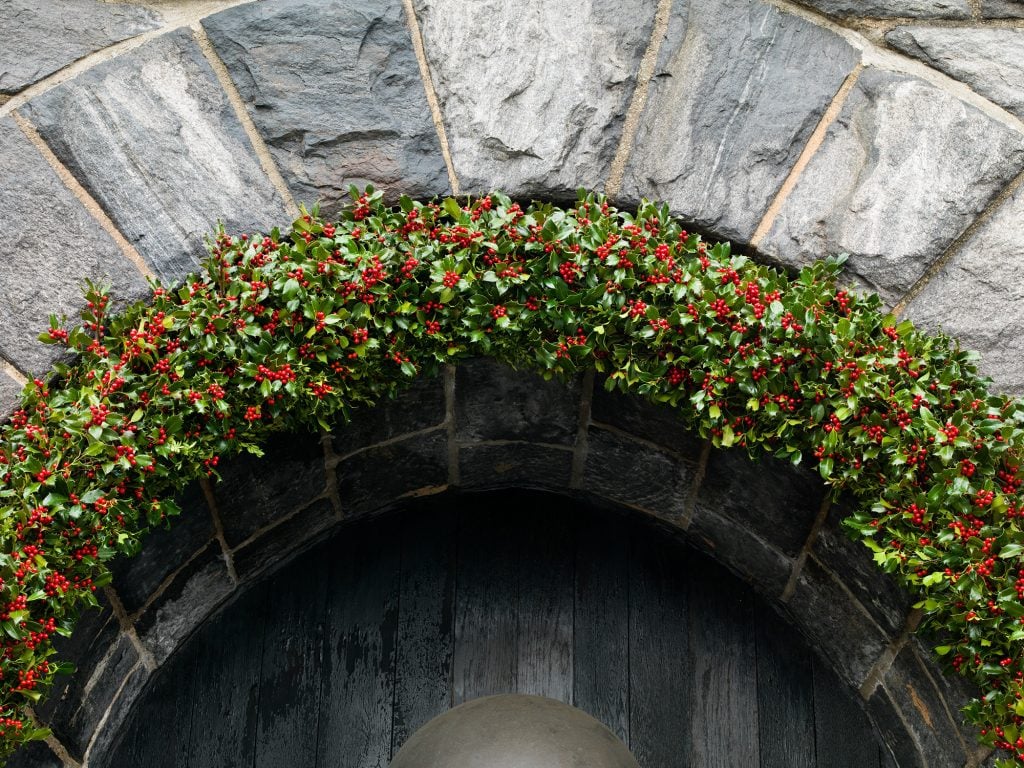
A holly arch during the 2013 holiday display at the Met Cloisters. Photo courtesy the Metropolitan Museum of Art.
Are there any other objects in the collection that have inspired you in your garden work, outside of the unicorn tapestries?
Oh yeah. Without a doubt, the Book of Flower Studies, which was recently acquired, is one of the most beautiful things I’ve ever seen. We got to flip through—I didn’t touch the pages of course—but our technician flipped through the pages. It almost looks like a little field guide of flowers that are so beautifully studied, they’re so easily identifiable. To me, that’s just a real inspiration. It feels so timeless. These plants are still here and we can still find all of this beauty and inspiration in the same things.
You’ll find we grow every single flower in [the book]. So I love to think, “What was this artist thinking about? And where was he finding these plants?” We had some herbals [books on natural remedies] that were out on display, and those are also wonderful to go through. The way that a nice chunky root of an allium is depicted. You could pull that out of the garden, and it would look exactly like that.
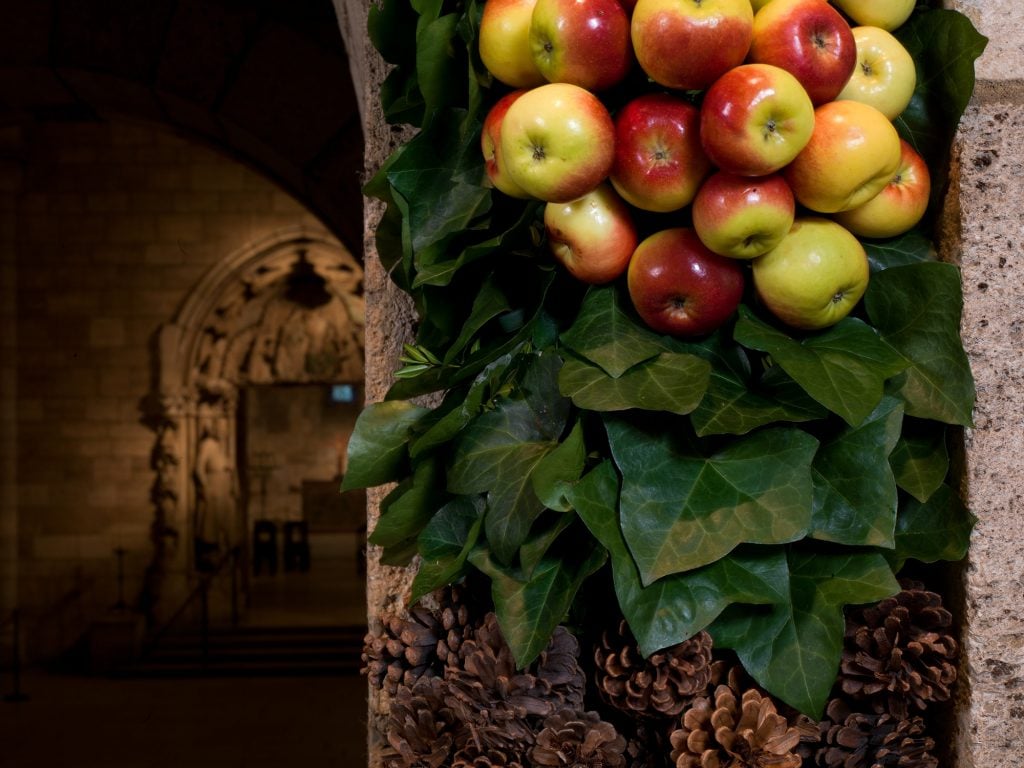
Photo courtesy the Metropolitan Museum of Art.
What does a typical day look like for you and your team these days?
We start at eight AM. We have a lot of potted plants, citrus and myrtles, bay laurel, lots of stuff like that. That’s all been moved inside. Work this time of year shifts more towards potted plant maintenance and making sure everything’s well watered, that there are no yellowing leaves. We call that our morning round, between 8 and 10, just getting everything ready for the public.
Then of course we do a pass through of the gardens. Right now, we’re doing our big cutback of plants. So lots of maintenance gearing up for the winter, cutting all of our perennials back. We just finished planting 15,000 bulbs. We’re getting the beds prepped for that, then we’ll plant those in, and make sure everything’s tucked in.
I even love sweeping the garden. To me it feels like a really important thing. Of course it’s the fall and leaves start dropping. But again, finding that balance of making things still look neat, and real, and well-maintained is the focus right now.
Then we gear up for our holiday decorations, which will start in the next few days. And then when we get back from Thanksgiving, we’ll look at lots of potted plants… lots of cyclamen, rosemary, hellebores, fragrant jasmine. We want to just fill that gallery space with potted plant material.
Then we’ll do the big installation with the arches, and we’ll use fresh English holly, fresh apples, fresh ivy, and hazelnuts. That will go up in the middle of December, which is exciting. We’re picking and washing ivy leaves, and polishing apples and doing all sorts of super-obsessive repetitive work—out of love.
